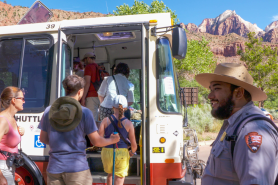

You may know her as the rogue, surfboard-stealing sea otter making waves off the coast of California, but the crew at the Monterey Bay Aquarium knows her as Otter 841. Last week, the U.S. Fish and Wildlife Service (USFWS) and California Department of Fish and Wildlife (CDFW) announced they are responding to reports of a five-year-old female southern sea otter exhibiting “concerning and unusual behaviors” in Santa Cruz, California.
Indeed, Otter 841 has been approaching surfers and kayakers in the area, in some cases aggressively, even biting surfboards or—in at least one case—floating off on top of them as surfers watch helplessly. Wildlife authorities hope to safely catch the otter so she is no longer a danger to herself, humans, or surfboards, but this animal is making quite a reputation for herself by playing hard-to-get.
Why does this otter seem to have a personal vendetta against surfers, anyway? In an interview with Outdoors.com, Monterey Bay Aquarium staff involved in the recovery attempts of Otter 841 discuss this unique situation and assess theories about what’s behind the animal’s unusual behavior.

Otter 841
Jessica Fujii is the manager of the Monterey Bay Aquarium’s sea otter program, including sea otter rescue, rehabilitation, and release, as well as the surrogacy program. She’s also the principal investigator of sea otter conservation research. Fujii says Otter 841 is a graduate of the aquarium’s Sea Otter Research and Conservation (SORAC) program that was released into the wild in 2020. Like all releases, Otter 841 was tagged with a radio transmitter that would allow wildlife researchers to keep track of her movements.
“She was released in 2020, and she was out in the wild for a little over a year,” Fujii says. “She was being monitored by biologists and our volunteers, behaving just like any other sea otter before we saw these interactions. [. . .] When those behaviors did start, we initially worked with California Department of Fish and Wildlife to do some ‘hazing,’ and those were initially successful. She moved on to a different area, and there were no [more] reports of these interactions, but she has since returned and started up again.”

The Root of the Behavior
Even though Otter 841 is being monitored by radio transmitter, there is no way to know what sort of human interactions—positive, neutral, or otherwise—she’s had throughout her lifetime. One theory is that she’s received food from humans in the past, which has made her abnormally comfortable approaching them.
“We have seen in prior cases where being fed by the public has led to similar behaviors of being a little bit more aggressive or not displaying the same weariness of people,” Fujii says. “But we have no evidence of that happening with this particular otter. There’s been no reporting of anyone seeing that happening.”
Another theory is hormonal surges that are causing the otter to act out.
“There also have been cases where different hormonal surges have led to this [behavior] temporarily,” Fujii adds. “So we don’t know for sure. If this otter is pregnant, we would need a more thorough exam to determine that, and so that is one hypothesis, but it’s not known if this is related to hormones at all.”
In former cases where hormones were determined to be the cause, Fujii says the behavior has typically not been as persistent as it has been with Otter 841.

Is Otter 841 Dangerous?
As long as this otter is approaching humans aggressively and biting surfboards, she is a danger to herself and to humans.
“Otters have strong jaws and teeth that they need to survive to eat the shellfish that they consume, and so, if an otter did choose to bite someone, it would have an impact,” Fujii says.
She says for the sake of wildlife as well as surfers, kayakers, and other people sharing outdoor spaces with sea otters, humans should keep their distance from these animals.
“You never know when a wild animal is going to feel threatened enough to defend themselves,” she adds. “Everything that the public can do to keep wildlife wild [helps], so even if they’re not going out and feeding any animals, keep their distance. So if the otter’s resting or doing its thing [. . .] keep at least 50 feet away.”
If you’re a surfer in the Santa Cruz area worried about Otter 841, Fujii says if you see an otter starting to approach you, you should do more than just keep your distance—you should actively move away from it until the animal moves on to another area.
You might miss out on some waves, but your board will thank you later.

The Uncatchable Otter
So far, Otter 841 has evaded capture from seasoned professionals.
“This is not an easy task, [and] we’re working with folks from other agencies who have years of experience safely handling sea otters,” Fujii says. “This sea otter in particular, she’s actually very healthy right now. So this is not a typical stranding response for the Monterey Bay Aquarium where we’re bringing in sick, injured, or orphaned sea otters. So it’s just been assessing conditions every day based on weather [and] the otter’s behavior and coming up with strategies depending on the situation. And that’s really all they can continue to do while this is ongoing.”

What’s in Store for the Surfing Otter?
USFWS has determined the best course of action is to capture Otter 841 and place her in an Association of Zoos and Aquariums (AZA)-accredited facility where she can live a comfortable life as an ambassador for her species, which is threatened in the wild.
“Everyone’s overall goal is to maintain the safety of the public and the wildlife—and individual sea otters,” Fujii says. “So all the different steps that we’re taking are really with that goal in mind. It’s become clear to the service in particular and that’s why they’re recommending the capture and then placing this otter for long-term care at a zoo or aquarium where she can still have a wonderful long life and still contribute to the benefit of her species by being an ambassador.”

Sea Otters as a Keystone Species
Fujii stresses that it is not typical for southern sea otters to approach humans aggressively, and people should not fear them. They should, however, have a healthy respect for all wildlife, including sea otters.
Sea otters are vital to the health of their habitats. They’re what’s called a keystone species—a species that has a disproportionately influential impact on its ecosystem. Along the coast of California, southern sea otters help ensure the health and viability of kelp forests, because they eat sea urchins that would otherwise mow down the kelp and destroy an important habitat for so many marine species.
In fact, this almost happened. The fur trade in the 18th and 19th centuries nearly wiped out southern sea otters along the coast of California, and these animals were thought to be extinct as recently as the early 20th century. A small pocket of southern sea otters survived, though, and were discovered in 1938 off the coast of Big Sur on California’s central coast.
Thanks in part to legal protection under the Endangered Species Act in the U.S., California’s population of southern sea otters has begun to recover from that core group of 50 discovered near Big Sur to around 3,000 today.
How long do you think it’ll take to catch this elusive surfing sea otter?









